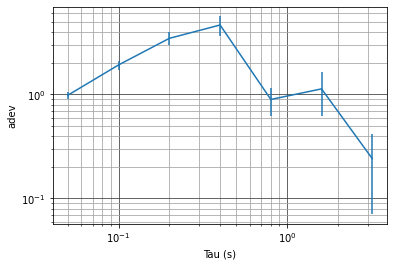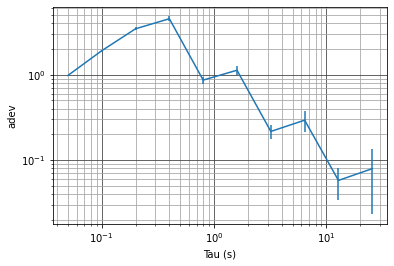I want to understand how to interpret ADEV plots. I was of the understanding that if we see a peak at 1sec of TDEV plot there is a 1Hz noise in Time Interval Error(TIE) Capture.
To understand the relationship between TIE and TDEV I considered TIE to be a sinusoidal wave of 1Hz sampled using a signal of 20Hz (much greater than Nyquist requirement) and for a period of 10sec (tmax)
Sharing the code used:
import numpy as np import allantools from matplotlib import pyplot as plt # import ipywidgets as widgets from ipywidgets import interact, fixed np.seterr(divide='ignore', invalid='ignore') # data generation # signal characteristics and sampling characteristics freq = 1 tmin = 0 tmax = 10 sampling_period = 1/16 def generate_data(freq, tmin, tmax, sampling_period): t = np.arange(tmin,tmax,sampling_period) data = np.sin(2*np.pi*t*freq) #data = return data,t def plot_data(ax, t, data): ax.plot(t,data) def compute_adev(data, rate): # Load data a = allantools.Dataset(data=data,rate=rate,data_type="phase") # compute mdev a.compute('adev') # Plot it using the Plot class b = allantools.Plot() b.plot(a, errorbars=True, grid=True) # You can override defaults before "show" if needed b.ax.set_xlabel("Tau (s)") b.show() def call_func(freq=1, tmin=0.0, tmax=10.0, sampling_period=1/20): data,t = generate_data(freq, tmin, tmax, sampling_period) ax=plt.axes() plot_data(ax,t,data) compute_adev(data, 1/sampling_period) call_func(1, 0.0, 10.0, 1/20) The below Tdev Plot is using tmax=10.0
 The below Tdev Plot is using tmax=100.0
The below Tdev Plot is using tmax=100.0
Question:
The plot is not having peak at 1Hz. Since the input TIE is periodic over 1Hz, shouldn't we expect a peak at Tau = 1sec ?
PS. since i need 300points to create a tag, tagging time-freq and time-domain


